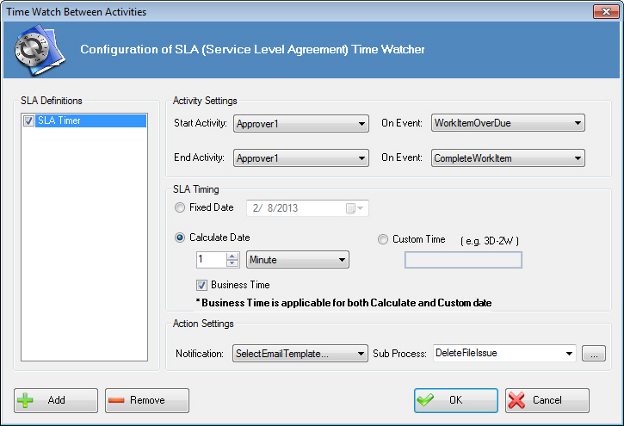Sets up the SLA timer, including the range
of AgileShapes you want to time.
Navigation
- In AgilePoint Envision, open a process template.
- Navigate to the Extender stencil.
- On the Extender stencil, drag the
Service Level Agreement AgileShape, and drop it on the process template.
- To view the entire list of properties, in the Design Tasks pane, click Show Properties.
- On the SLATimer field, click the Ellipses button.
Field Definitions
| Field Name |
Definition |
Add
|
- Function:
- Creates a new timer with a name you specify.
|
Remove
|
- Function:
- Deletes the selected timer.
|
Start Activity
|
- Definition:
- Specifies the activity upon which you want to start the timer.
- Allowed Values:
- The name of your activity.
- Default Value:
- None.
|
End Activity
|
- Definition:
- Specifies the activity upon which you want to end the timer.
- Allowed Values:
- The name of your activity.
- Default Value:
- None
|
On Event
|
- Definition:
- Specifies the particular event of the activity you want to start or end the timer.
- Allowed Values:
- The name of your event.
- Default Value:
- None
- Example:
- For a Manual activity, you can choose the AssignWorkItem event.
|
Fixed Date
|
- Definition:
- Sets a particular date to expire the timer.
- Allowed Values:
- Selected - Specifies to use a particular date to expire the timer.
- Deselected - Specifies not to use a particular date to expire the timer.
- Default Value:
- Selected.
|
Calculate Date
|
- Definition:
- Determines whether to calculate a date to expire the timer based on the information you enter.
- Allowed Values:
- Deselected - Specifies not to calculate a date to expire the timer.
- Selected - Specifies to calculate a date to expire the timer. This
calculation includes the following elements:
- Default Value:
- Deselected
- Example:
- If the length is set to 3, and the time unit is set to Day, this indicates 3 days. For example, this sets a duration of 3 days after which the timer expires.
|
Custom Time
|
- Definition:
- Specifies a custom attribute that identifies a timespan for the timer expiration.
- Allowed Values:
- A custom attribute where the value is in the value xD-yW.
- xD - Indicates x number of days.
- yW - Indicates y number of weeks.
- Default Value:
- None
- Custom Attributes:
- Yes
- Example:
- 3D-2W
This value indicates 3 days plus 2 weeks.
|
Business Time
|
- Definition:
- Determines whether the time span represents actual time, or business hours only.
- Allowed Values:
-
- True - The time span represents a span of business hours only. For
example, 5 days of business time might be equivalent to 7 days of actual time. 8
hours of business time might be equivalent to 24 hours of actual time.
- False - The time span represents actual time. It is unaffected by any
business time configuration settings.
- Default Value:
- False
- Example:
- The Business Time property is set to True, and
business hours are configured as 9 a.m. to 5 p.m. A Manual
AgileShape with a Time Span of 6 business hours is entered at 4 p.m. on
Tuesday, then the activity must be completed by 2 p.m. on Wednesday.
- Property Group:
- Basic
|
Notification
|
- Definition:
- Specifies the name of an email template used to send the email notification when the timer
expires.
- Allowed Values:
- The name of your email template.
- Default Value:
- None.
|
Sub Process
|
- Definition:
- Specifies the name of the process template that is started as a sub process when the timer expires. The list is
populated from the subprocesses in your process model.
You can use process attributes to pass date from the
parent process to the subprocess.
- Allowed Values:
- The name of your process template.
If you configure a subprocess, you can
set up process attributes to pass data from the
parent process to the subprocess, similar to
the SubProcess AgileShape.
Click the Ellipses button to open the Initial Attributes Configuration Window
- Default Value:
- None.
- Custom Attributes:
- Yes
|

